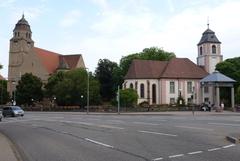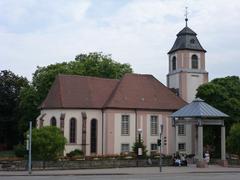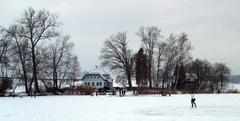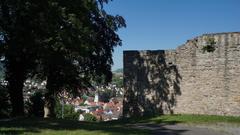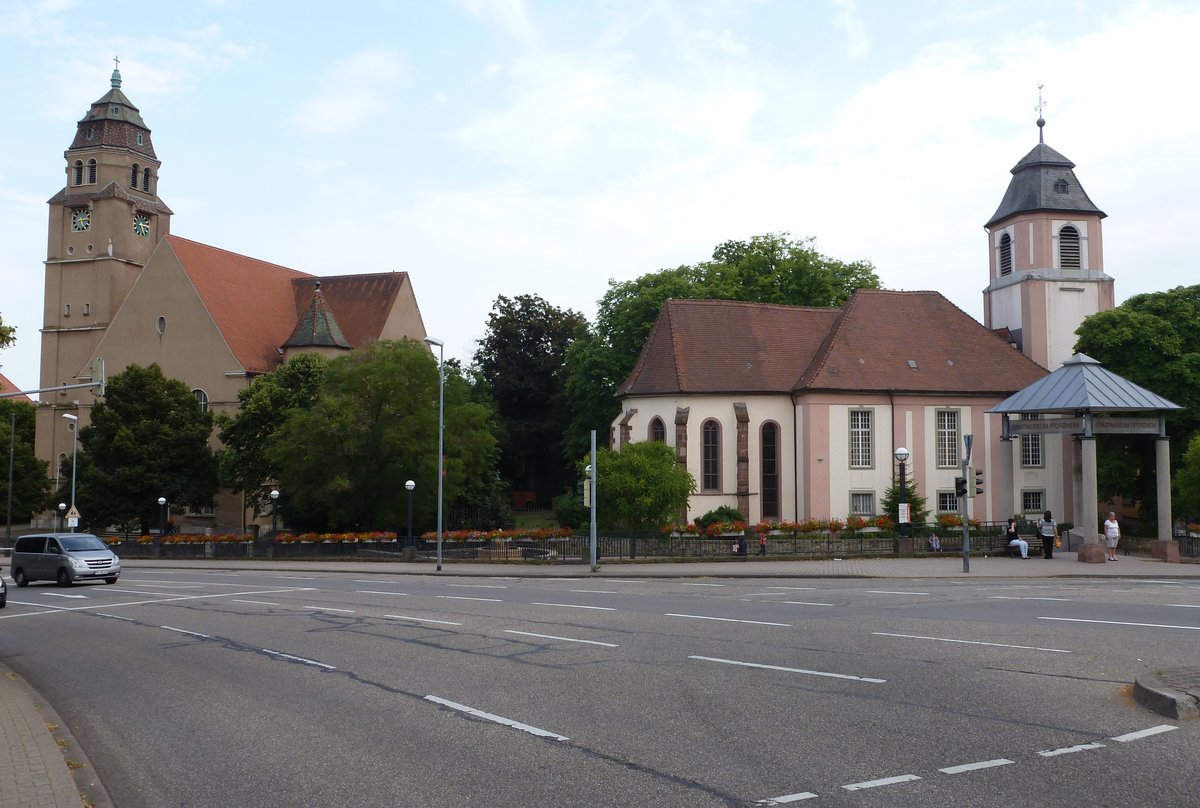
Visiting Stadtmuseum Pforzheim: Hours, Tickets, and Historical Insights
Date: 01/08/2024
Introduction
Discover the rich tapestry of Pforzheim’s history at the Stadtmuseum Pforzheim, a cultural gem nestled in Baden-Württemberg, Germany. Located in the historic St. Martin parish church and the Old Schoolhouse, this museum offers a captivating journey through time, from the medieval period to modern-day Pforzheim. The Stadtmuseum Pforzheim is renowned for its engaging exhibitions that showcase the city’s evolution, particularly its famed goldsmithing and watchmaking industries (Stadtmuseum Pforzheim). Visitors can delve into a wealth of historical artifacts, interactive displays, and preserved workshops that vividly illustrate the city’s storied past. This guide will provide you with comprehensive visitor information, including ticket details, opening hours, and travel tips, ensuring a memorable and enriching experience at the Stadtmuseum Pforzheim.
Table of Contents
- Historical Background
- Visitor Information: Tickets, Opening Hours, and Accessibility
- Travel Tips: How to Get to Stadtmuseum Pforzheim and Nearby Attractions
- Special Events and Guided Tours at Stadtmuseum Pforzheim
- Photographic Spots and Best Times to Visit Stadtmuseum Pforzheim
- FAQ Section
Historical Background
Origins and Early History
The Stadtmuseum Pforzheim is housed in a historically significant area that includes the deconsecrated St. Martin parish church and the Old Schoolhouse. This location has been a cornerstone of Pforzheim’s cultural and educational landscape since the Middle Ages. The museum’s buildings themselves are architectural relics, with the Old Schoolhouse dating back to the 15th century. The St. Martin parish church, originally consecrated in the 12th century, was deconsecrated and repurposed for the museum in 1974 (Stadtmuseum Pforzheim).
Medieval Pforzheim
During the medieval period, Pforzheim was a bustling center of trade and craftsmanship. The city was particularly known for its goldsmiths and watchmakers, trades that have left a lasting legacy on the region. The museum’s permanent exhibition includes fully preserved workshops that provide a vivid picture of these traditional crafts. These workshops are located on the ground floor of the Old Schoolhouse and feature tools and equipment used by goldsmiths, watchmakers, shoemakers, saddlers, and brush binders (Stadtmuseum Pforzheim).
Renaissance and Reformation
The Renaissance period brought significant changes to Pforzheim, influenced by prominent figures such as Johannes Reuchlin and Philipp Melanchthon. Reuchlin, a native of Pforzheim, was a humanist and scholar who played a crucial role in the early stages of the Reformation. The museum features a historically accurate printing press that symbolizes the media revolution of Reuchlin’s time. This exhibit is located on the upper floor of the Old Schoolhouse and highlights the transformative impact of the printing press on society (Stadtmuseum Pforzheim).
The 17th and 18th Centuries
The 17th and 18th centuries were tumultuous times for Pforzheim, marked by events such as the “Weiberkrawall” (Women’s Riot) around 1700 and several devastating city fires. The museum’s exhibits in the St. Martin parish church provide detailed accounts of these events. One notable exhibit is the depiction of the “Weiberkrawall,” a tumultuous dispute over privileges that involved significant public unrest. Additionally, the museum covers the impact of the plague in 1501 and the various city fires that ravaged Pforzheim in the 17th century (Stadtmuseum Pforzheim).
The 19th Century and Industrialization
The 19th century saw Pforzheim emerge as a significant industrial hub, particularly in the fields of jewelry and watchmaking. The museum’s permanent exhibition includes models and display boards that illustrate the professions of tanners and rafters, which were integral to the city’s economy during this period. The industrial boom also led to the development of new technologies and manufacturing processes, many of which are showcased in the museum’s exhibits (Stadtmuseum Pforzheim).
The 20th Century and World War II
The 20th century brought both progress and devastation to Pforzheim. The city was heavily bombed during World War II, with a significant portion of it being destroyed on February 23, 1945. The upper floor of the St. Martin parish church is dedicated to this dark chapter in the city’s history. Here, visitors can find a cinema that screens films about the city’s destruction and subsequent rebuilding efforts. This section of the museum provides a poignant reminder of the war’s impact on Pforzheim and its residents (Stadtmuseum Pforzheim).
Post-War Reconstruction and Modern Era
Following the devastation of World War II, Pforzheim underwent a significant reconstruction phase. The museum’s exhibits highlight the city’s recovery and the efforts to preserve its cultural heritage. One of the standout exhibits is the functional replica of the Benz-Patent-Motorwagen, also known as the Bertha-Benz-Mobil. This exhibit celebrates the pioneering spirit of Bertha Benz, who undertook the first long-distance automobile journey in 1888, showcasing the innovative spirit that has long been a part of Pforzheim’s identity (Stadtmuseum Pforzheim).
Special Exhibitions and Current Projects
In addition to its permanent exhibits, the Stadtmuseum Pforzheim hosts regular special exhibitions that delve into various aspects of the city’s history and culture. These exhibitions provide visitors with fresh perspectives and new insights into Pforzheim’s rich heritage. One of the current projects is “Raum 243,” described as a “room of possibilities,” which aims to offer a dynamic space for exploring contemporary issues and historical themes (Stadtmuseum Pforzheim).
Visitor Information: Tickets, Opening Hours, and Accessibility
The museum offers a unique visitor experience, combining historical exhibits with interactive elements. The Kräutergarten (herb garden) on the museum grounds is a tranquil spot where visitors can relax and enjoy the serene atmosphere. The garden features sculptures by Emil Salm and Ignaz Lengelacher, adding an artistic touch to the natural surroundings. Additionally, the museum includes a barefoot path and an orchard, inviting visitors to engage with the environment in a sensory manner. However, it is important to note that the museum is not fully accessible to individuals with mobility impairments. The museum is open on Wednesdays and Thursdays from 14:00 to 17:00, and on Sundays and public holidays from 10:00 to 17:00. Admission to the museum is free, making it an accessible option for all visitors. For group tours and educational visits, the museum provides special programs and guided tours, which can be arranged through the Tourist Information office (Stadtmuseum Pforzheim).
Travel Tips: How to Get to Stadtmuseum Pforzheim and Nearby Attractions
To get to the Stadtmuseum Pforzheim, visitors can take advantage of public transportation options available in the city. The museum is conveniently located near several bus and tram stops, making it easily accessible. For those driving, there are nearby parking facilities. Additionally, visitors can explore nearby attractions such as the Jewelry Museum and the Pforzheim Wildpark, enhancing their cultural and recreational experience in Pforzheim.
Special Events and Guided Tours at Stadtmuseum Pforzheim
The Stadtmuseum Pforzheim regularly hosts special events and guided tours that provide deeper insights into the city’s history and culture. These events range from thematic tours to interactive workshops, catering to various interests and age groups. Check the museum’s official website for updates on upcoming events and tours to enhance your visit.
Photographic Spots and Best Times to Visit Stadtmuseum Pforzheim
For photography enthusiasts, the Stadtmuseum Pforzheim offers several picturesque spots. The Kräutergarten and the historical architecture of the St. Martin parish church and the Old Schoolhouse provide excellent photo opportunities. The best times to visit the museum are during weekdays to avoid the weekend crowds and during special exhibitions for unique photographic subjects.
FAQ Section
What are the visiting hours for Stadtmuseum Pforzheim?
The museum is open on Wednesdays and Thursdays from 14:00 to 17:00, and on Sundays and public holidays from 10:00 to 17:00.
How can I purchase tickets for Stadtmuseum Pforzheim?
Admission to the museum is free. For special programs and guided tours, you can arrange tickets through the Tourist Information office.
What are the best times to visit Stadtmuseum Pforzheim?
The best times to visit are during weekdays to avoid crowds and during special exhibitions for unique experiences.
Are guided tours available at Stadtmuseum Pforzheim?
Yes, guided tours are available and can be arranged through the Tourist Information office.
Conclusion
A visit to the Stadtmuseum Pforzheim is more than just a walk through history; it’s an immersive experience that brings the past to life. From its medieval roots and Renaissance influences to its industrial boom and the poignant memories of World War II, the museum offers a holistic view of Pforzheim’s rich heritage. The museum’s free admission makes it an accessible cultural treasure for all visitors. Whether you’re exploring the preserved workshops of traditional crafts, learning about the revolutionary impact of the printing press, or reflecting on the city’s wartime experiences, the Stadtmuseum Pforzheim provides invaluable insights into the resilience and innovation of Pforzheim’s people. Don’t miss the opportunity to explore nearby attractions like the Jewelry Museum and the Pforzheim Wildpark, which further enhance the cultural and recreational offerings of this vibrant city. Plan your visit today and embark on a fascinating journey through Pforzheim’s historical landscape (Stadtmuseum Pforzheim).
References
- Stadtmuseum Pforzheim. (n.d.). Retrieved from Stadtmuseum Pforzheim
- Stadtmuseum Pforzheim. (n.d.). Retrieved from Stadtmuseum Pforzheim
